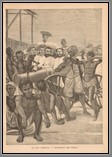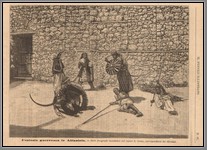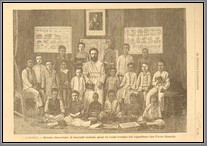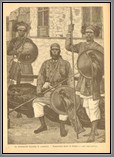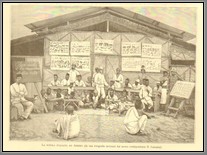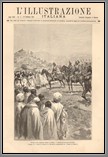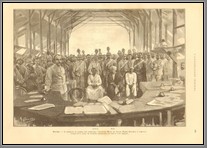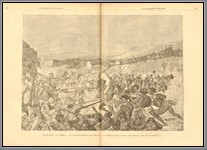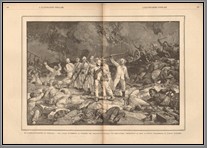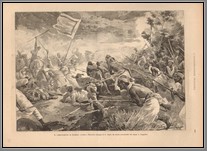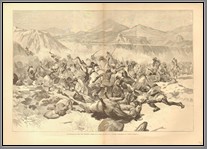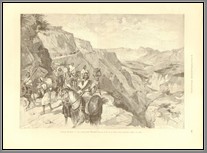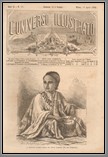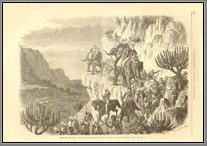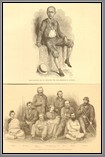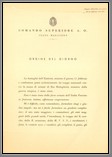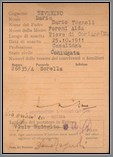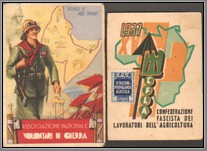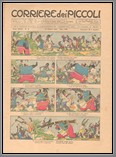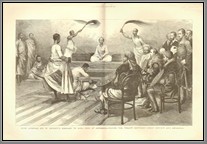 ETH 2161884 fold-out illustration of Admiral Sir W. Hewett’s Embassy to King John of Abyssinia – signing the treaty between Great Britain and Abyssinia. Also an illustration of Egyptian troops moving to the Ethiopian border. B
ETH 2161884 fold-out illustration of Admiral Sir W. Hewett’s Embassy to King John of Abyssinia – signing the treaty between Great Britain and Abyssinia. Also an illustration of Egyptian troops moving to the Ethiopian border. B
Price: $70.00
Note: Khedive Ismail Pasha, emboldened by Egypt’s rise as a significant force in Africa, attempted to colonize both Sudan and Ethiopia in order to create an Egyptian-African Empire. This led to a war with Ethiopia, and amongst other things, the removal of Khedive Ismail from power by the British. The war contributed to the 1882 British occupation of Egypt and its outposts along the Red Sea as it had further drained Khedive Ismail’s coffers and increased the risks of insolvency of his regime. The hostile negotiations for a peace settlement between Egypt and Ethiopia lasted nine years with Britain refusing to support any settlement whereby Egyptians would look as if they had been vanquished. With the rise of the Mahdi of Sudan and his threatening of British and Egyptian interests, Britain foresaw the need for an Egyptian-Ethiopian treaty. Consequently, on June 3, 1884, the Hewett or Adwa Treaty was signed between Ethiopia and Britain, the occupier of Egypt. The principal condition on Ethiopia under this treaty was the facilitation of the evacuation of Egyptian troops from their positions in Sudan and parts of Northern Ethiopia.
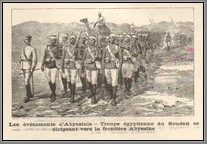 ETH 216Emperor Yohannes lost his life on March 9, 1889, during one of the subsequent battles against the Mahdi. In the words of Sven Rubenson, Yohannes through the treaty traded “one weak enemy (Egypt) for two strong ones, the Mahdists and Italy”. Paranoia that Egypt without the Nile, a barren desert, was a liability as opposed to an asset and fearful that France, Britain’s bitter colonial rival, would encroach on the waters of the Nile led to the Anglo-Italian collusion over Ethiopia. Britain was prepared to guard the White Nile; however, they wanted someone to watch over the Blue Nile and its Ethiopian sources and tributaries. The Italians were desperate to colonize Ethiopia and Britain was ready to support them so long as they watched over Britain’s imperial interests. Thus, Britain gave Massawa to Italy in 1885-1886 and the dramatic and costly Italian attempts at colonizing Ethiopia ensued. Britain had thus disposed of its responsibility under the Hewett Treaty, which required that Massawa remain under British protections.
ETH 216Emperor Yohannes lost his life on March 9, 1889, during one of the subsequent battles against the Mahdi. In the words of Sven Rubenson, Yohannes through the treaty traded “one weak enemy (Egypt) for two strong ones, the Mahdists and Italy”. Paranoia that Egypt without the Nile, a barren desert, was a liability as opposed to an asset and fearful that France, Britain’s bitter colonial rival, would encroach on the waters of the Nile led to the Anglo-Italian collusion over Ethiopia. Britain was prepared to guard the White Nile; however, they wanted someone to watch over the Blue Nile and its Ethiopian sources and tributaries. The Italians were desperate to colonize Ethiopia and Britain was ready to support them so long as they watched over Britain’s imperial interests. Thus, Britain gave Massawa to Italy in 1885-1886 and the dramatic and costly Italian attempts at colonizing Ethiopia ensued. Britain had thus disposed of its responsibility under the Hewett Treaty, which required that Massawa remain under British protections.

